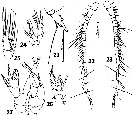
issued from : Figueroa
in J. Crustacean Biol., 2011, 31 (1). [p.158, Fig.3, H-I]. As
Ridgewayia typica after Por (1979), from Bitter Lakes (Suez Canal). Probably as
Ridgewayia sp.
Male: H, right P5; I, left P5.
Nota: The P5 are remarkably similar to that of
R. tortuga. The segmentation and armature of the left P5 are the same, except for the presence of a small outer seta on the basis of Yeatman's specimen. This seta is absent in Por's drawing and in
R. tortuga. The left endopod has the same oblong shape with a distal tooth-like element in all three. The right P5 in
R. tortuga and yeatman's and Por's specimens also have the same segmentation and armature, except for a thin seta present on the inner margin of the 1st exopod segment as shown on Yeatman's drawing; in
R. totuga and Por's specimen there is a patch of fine setae on this inner margin. The right endopod has the same elongated shape with a forked tip at the end in all three males. Yeatman described a set of fine seta-like structures on this forked tip, not present in
R. tortuga or in Por's drawing. Yeatman's and Por's specimens are depicted as having an unequally bifurcated tip, while
R. tortuga has a symatrically bifurcated tip.
Yeatman's specimen and
R. tortuga, both have a 25-segmented left A1. But Yeatman's specimen has a 22-segmented right A1, while
R. totuga has only 20 segments. The unusual geniculation on the right A1 of
R. tortuga between articulated segments 9 and 10 (with 11 segments beyond the geniculation) is not mentioned by Yeatman (1969) nor has it been observed in any other species of
Ridgewayia But such articulation has been found elsewhere in Ridgewayiidae by Suarez-Morales and Iliffe (2007)
The swimming legs in both have the same segmentation and armature that include only 7 setae on the terminal exopod segment of P2 instead of the 8 found in all other
Ridgewayia.





